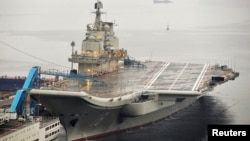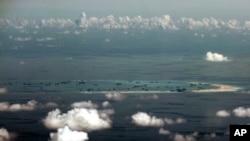Chinese warships, led by the country’s first aircraft carrier, the Soviet-built Liaoning, sailed past Taiwan and into the South China Sea earlier this week. It was a move that caught the attention of both Taiwan and Japan, who closely observed the six-vessel group.
“China is developing a regional military capability,” said Brad Glosserman, security analyst at Pacific Forum. "The Chinese believe that they need to have the capacity and the ability to protect their interests as they become increasingly far flung. They see that a power that aspires to the status it has, will have the a fully fledged military... they're going to go from a green water, in other words a close-water navy, to blue water, which is one capable of sailing in the oceans.”
Glosserman says part of that progression is possessing an aircraft carrier, and he says the world may be “very quick to tie it to other developments, and I think that we should look at this as something that China is going to do regardless.”
Dismissive reaction
In July 2016, the Permanent Court of Arbitration ruled against China’s land reclamation efforts in the South China Sea. Beijing dismissed the court’s award to Manila saying it didn’t have the requisite jurisdiction.
Paul Reichler, the lead attorney for the Philippines in the case, told VOA then, “I have heard what they have said… and what they have said for the past several months. The full weight of the responsibility that China has taken upon itself to set itself outside and above the law has not yet come to bear on China.”
The lack of consequences also might have contributed to Beijing’s further development of reefs in the South China Sea. The Asia Maritime Transparency Initiative noted China had built “significant point-defense capabilities, in the form of large anti-aircraft guns and probable close-in weapons systems” on seven reefs it controls in the Spratly chain.
'Limited options'
Speaking to VOA in August, Greg Poling, the Director of the Asia Maritime Transparency Initiative, forecast these events.
“Ultimately we have limited options. If China is absolutely committed to this strategy - no matter the diplomatic cost - then it's hard to see what the international community or those most involved, like U. S. and Japan, can do,” said Poling.
Poling said countries might try to deter China, but ultimately it was a long-term issue and one in which it was hoped that Beijing eventually would realize that great powers don’t act outside the law.
And that, Glosserman says, is the most troubling aspect of Beijing’s actions because it’s “painfully obvious and it is [Beijing’s] unwillingness to just be forthright about the capabilities that it is developing [and] its refusal to just acknowledge… what it has... builds real distrust.”
Victor Beattie contributed to this report.














